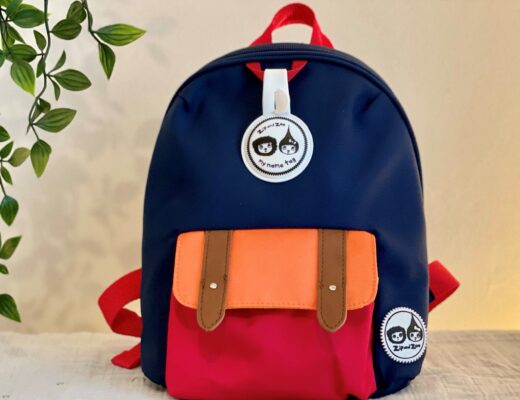The nation is currently in lockdown, all the shoe stores are closed and I can’t get Jin measured!
On top of that, different brands have different kids shoe sizes, its so confusing!
I’ve provided a little guide on doing everything yourselves and you can see several size charts of popular brands at the end.
Measuring
You can measure your child’s foot at home by:
Method 1: Taking a piece of paper, pen and ruler, placing the bare foot on the paper with the heel against the wall, marking where the longest toe is and then measuring the distance from the toe to the edge of the paper.
Next have a nice print out all ready for you here but remember, it’ll be according to their kids shoe sizes so just look at the CM part.
Method 2: Purchasing a measuring gauge like this and measuring the length and width of the foot.

![]() Tip: Measuring is best done after the child has been out or running around a little because feet swell with more activity or heat.
Tip: Measuring is best done after the child has been out or running around a little because feet swell with more activity or heat.
How Often Should I Measure?
Every child is different of course but here’s a general guide to the frequency of measuring.
1st Year of Wearing Walking Shoes – Every 6-8 weeks
2nd Year Onwards – Every 3 months or so
3rd Year Onwards – Twice a Year
4 Years Onwards – Once or twice a year
Late Teens – Should have grown to full size
I also keep a regular eye on Jin’s trainers when he’s out and about. I give his foot a little squeeze, just to see if the trainer is getting too tight or his toe is reaching the end.
Check The Retailer’s Size Chart
Once you have the length of the foot, look at the ‘Heel to Toe CM’ column of your chosen brand’s size chart and check which of their UK/EU/US size matches that measurement.
Remember, if you look up 13cm for example at multiple brand sites, they may all show different sizes.
Accommodating Wide Feet
Jin has wide feet so that rules out a lot of styles and structured materials. Some retailers like Clarks and Start Rite have different width options – very helpful for little ones with extra wide feet or in Jin’s case, super chubby feet!
For wide feet, make sure the shoes have :
| A wide opening so the toddler’s foot will go in easily without having to push too much |
| Soft leather/Mesh/Knit upper, which will allow more flexibility |
| An overall wide design. If you look at the shoe from the top, wider designed toddler shoes are more rounded or chubby (compare Adidas and Nike image below) |
| Adjustable fastenings or are a slip-on style |
A Visual Comparison Of Narrow And Wide Styles
Here’s an example of a narrow and wide style.
You can see here that the Adidas on the left is slimmer and more structured. This one didn’t work for Jin because I could feel his feet were a little squished at the sides.
The Nike on the right uses soft mesh material, is more flexible and has a rounder shape overall. Jin’s chubby feet fit snugly in without being squeezed.
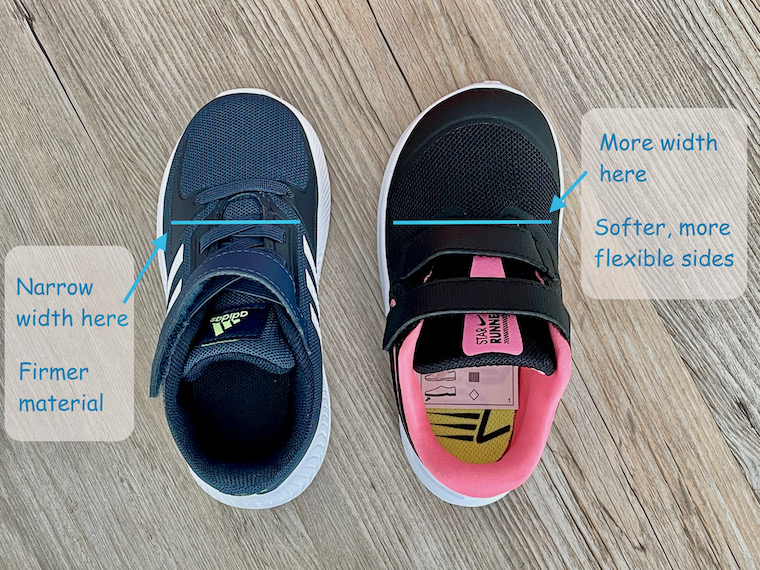
The Larger The Opening The Better!
For infants, a larger opening will make it so much easier to slide the foot in. This is such a time saver for us, as Jin can be really fidgety when we’re getting ready to go out!
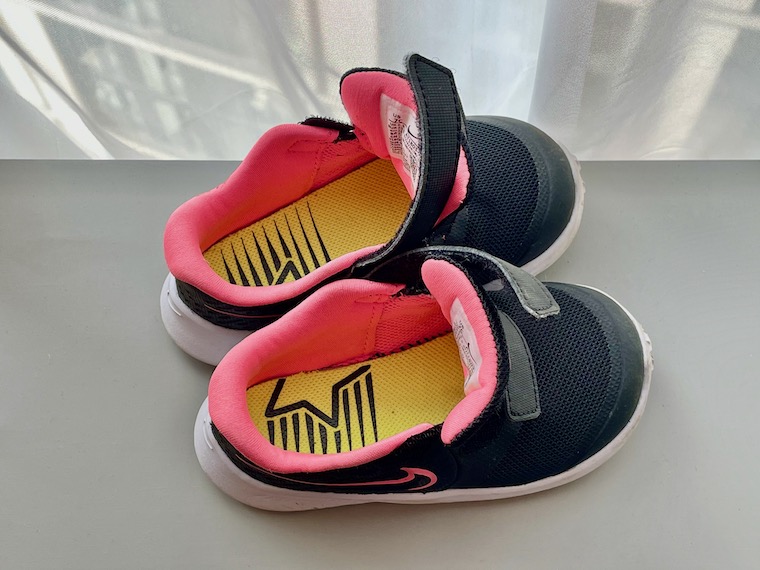
Built-In Growing Room
Some people may be tempted to get the next size up for their child’s fast growing feet, but stop! Double check on the retailer’s site whether their shoes have ‘built-in growing room‘.
The retailers I’ve come across that DO are Clarks and Start Rite.
How To Check The Fit
Put your child in the appropriate type of socks for the shoes they’re wearing. Fasten them properly and get them to stand up (if they’re too young to stand still, sit them on your lap).
Using your thumb, press the tip of the shoe to find the end of toddler’s longest toe (not necessarily the big toe).
It shouldn’t be pressed right up to the end of the shoe. Make sure there’s growing room of about 1-1.5cm.

Put your hand over the top of the shoe and feel all along the sides. The foot shouldn’t be pressed up firmly against the sides like it’s being squeezed and definitely shouldn’t be bulging over.
Lift the child’s ankle up with one hand and hold the heel of the shoe with the other. Pull up and down gently to check the heel is on securely, it shouldn’t move too much.
When standing, there shouldn’t be a noticeable gap between the child’s heel and the back of the shoe.
If the side of the shoe covers the ankle, make sure there’s sufficient padding. A poorly made shoe may rub and make the ankles sore.
Are Hand Me Downs OK?
Infant shoes are generally expensive, considering they’re only worn for such a short time, so it’s REALLY tempting to take another child’s perfectly good condition hand me downs.
This isn’t recommended because if they’re well worn-in shoes, the sole and sides would have moulded to the previous child’s feet. This means it won’t be a good fit for the new wearer and certain points may rub and cause pain.
Wellington boots are probably the only exception here because they’re not designed to mould to your feet and shouldn’t change shape. But make sure you give hand me down boots a good clean on the inside for hygiene.
My Tips
![]() You may want to opt for close cropped soles. Look at the shoe from above and check that the edges of the sole doesn’t flare out too much because this could make toddlers trip up over their own feet
You may want to opt for close cropped soles. Look at the shoe from above and check that the edges of the sole doesn’t flare out too much because this could make toddlers trip up over their own feet![]() Soft leather uppers or mesh will make it more flexible for toddler to move in rather than hard synthetic uppers
Soft leather uppers or mesh will make it more flexible for toddler to move in rather than hard synthetic uppers![]() For summer, look for cool comfort technology or mesh/knitted uppers for breathability
For summer, look for cool comfort technology or mesh/knitted uppers for breathability
Adjustable fastenings help fit the shoe better i.e. velcro![]() Observe how your toddler moves in the shoes. When Jin tried the Clarks Trainers and Nike Flex Runner, he started playing and running around the room immediately and looked completely comfortable.
Observe how your toddler moves in the shoes. When Jin tried the Clarks Trainers and Nike Flex Runner, he started playing and running around the room immediately and looked completely comfortable.
Final Thoughts
So there we have it, my guide on kids shoe sizes from how to measure little feet to tips on getting a great fit. Below, you’ll find a collection of charts showing kids shoe sizes from some popular brands in the UK.
Once the stores open, we’ll be able to get professional measurements but in the meantime, I hope this will help you find the perfect pair of shoes for your little one!

Shoe Size Charts – Popular Brands In The UK
Nike Kids Size Chart

Adidas Babies & Toddlers Size Chart
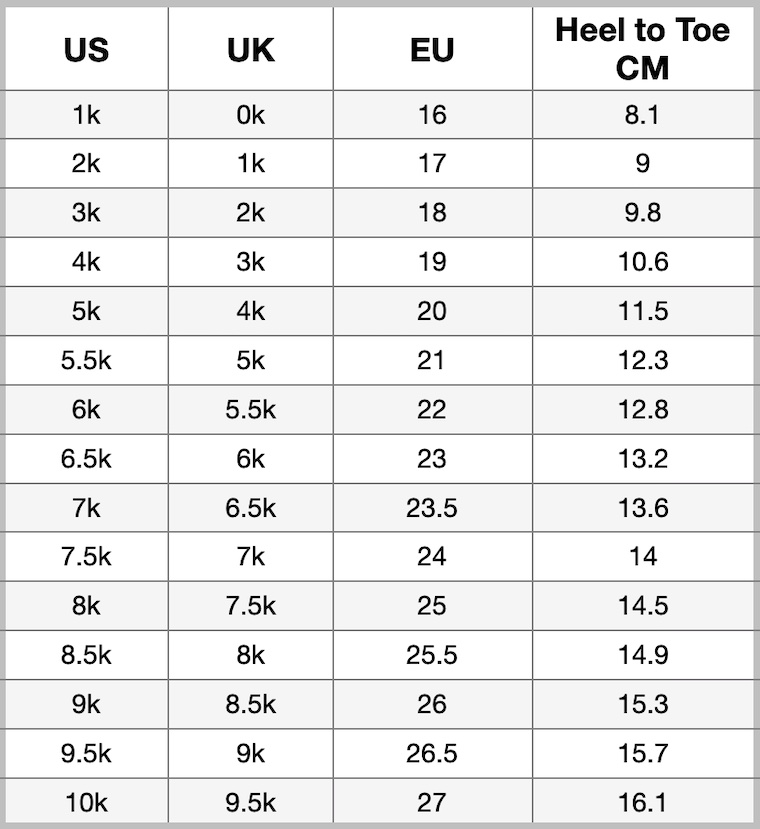
Nike & Adidas Sizes Compared

Next Younger Boys & Girls Size Chart
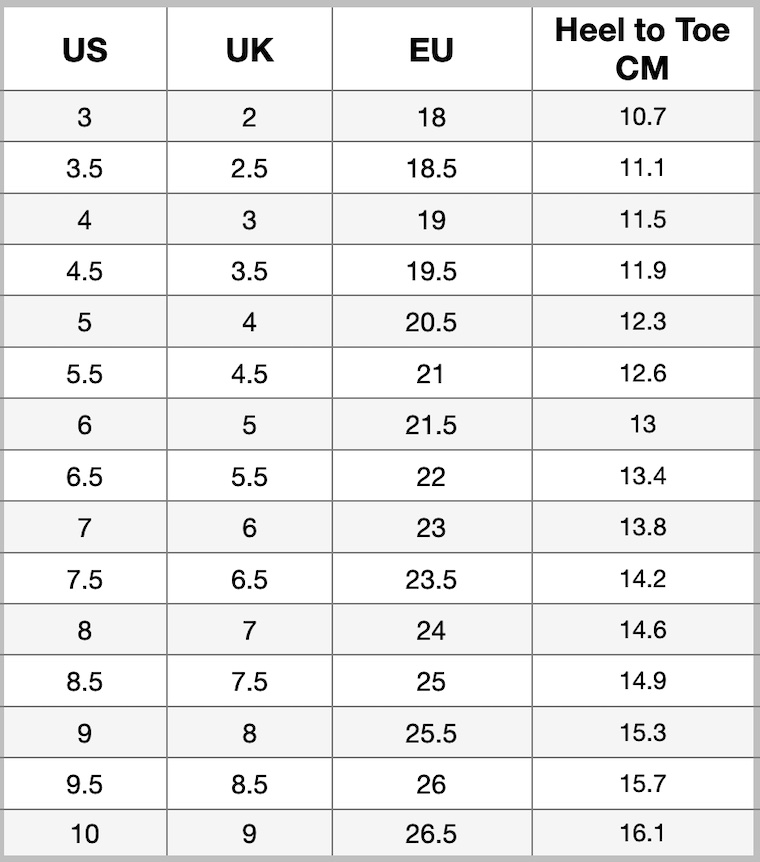
Ecco Kids Size Chart

Geox Baby Size Chart

Marks & Spencer Kids Size Chart
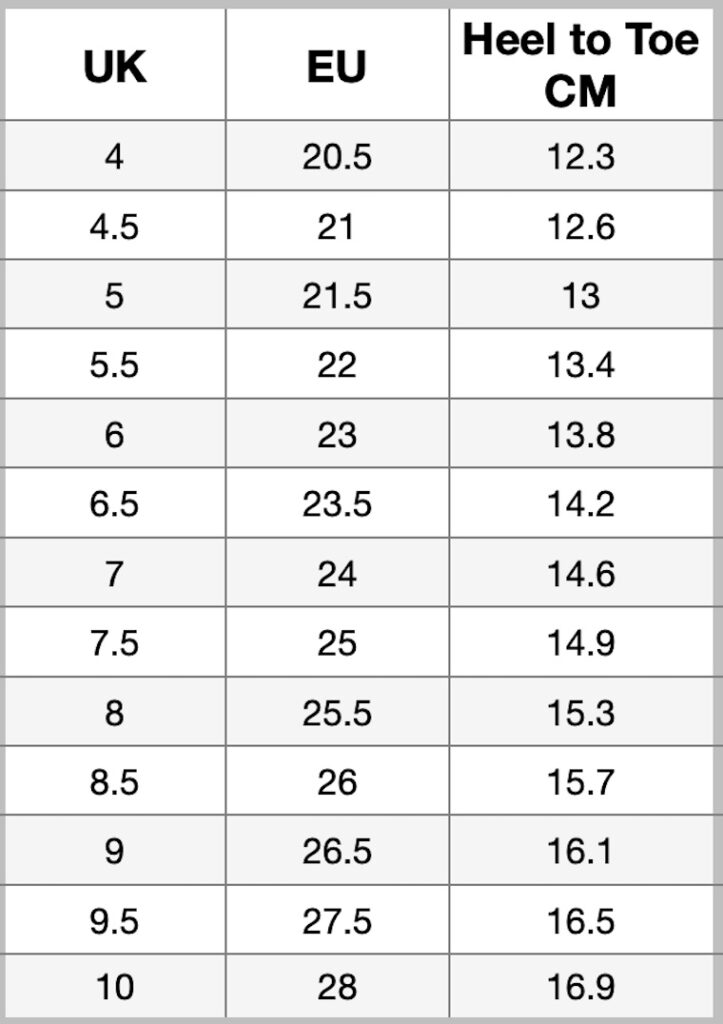
Clarks Kids & Babies Size Chart




